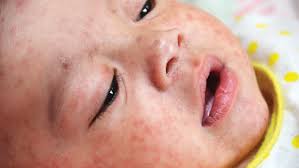‘No big deal’? More than 140K people died from measles in 2018
According to UNICEF, poor vaccination coverage and large pockets of unvaccinated children have resulted in devastating measles outbreaks in many parts of the world – including in countries that had high coverage rates or had previously eliminated the disease. In some cases, conflict, security or a breakdown in services are making it hard to reach children in remote or hard -to-reach areas. In others, parents are not vaccinating their children due to complacency, mistrust or misinformation about vaccines. This year, for example, the United States reported its highest number of cases in 25 years, while four countries in Europe — Albania, Czechia, Greece and the United Kingdom — lost their measles elimination status in 2018 following protracted outbreaks.
December 5, 2019
By Aaron E. Glatt
More than 140,000 people died from measles last year, with most deaths occurring in children aged younger than 5 years, according to findings published in MMWR [Morbidity and Mortality Weekly Report]. Measles cases increased 167% from 2016 to 2018, according to the report, with estimated mortality from the disease increasing since 2017.
“We’ve had a safe and effective measles vaccine for over 50 years,” Robert Linkins, MPH, PhD, chief of the CDC’s Accelerated Disease Control and Vaccine-Preventable Disease Surveillance Branch and chair of the Measles & Rubella Initiative, said in a news release. “These estimates remind us that every child, everywhere needs — and deserves — this life-saving vaccine. We must turn this trend around and stop these preventable deaths by improving measles vaccine access and coverage.”
WHO recommends 95% vaccination coverage with two doses of measles vaccine to effectively protect populations. However, vaccination rates have stagnated since 2010, with 86% of children receiving one dose of measles vaccine and 70% receiving the second dose, according to WHO and UNICEF estimates.
“The single most important thing is to vaccinate, and vaccinate earlier rather than later,” Infectious Diseases Society of America spokesperson Aaron E. Glatt, MD, chair of medicine and chief of infectious diseases at Mount Sinai South Nassau in Oceanside, New York, told Healio.

Most of the more than 140,000 people who died from measles in 2018 were children aged younger than 5 years.
Source: CDC/ Molly Kurnit, MPH
A total of 353,236 measles cases were reported worldwide in 2018. This year, 413,000 cases were reported as of mid-November — a threefold increase from the same month last year, according to WHO. The new report was released among several large ongoing measles outbreaks.
Samoa halted government services as part of a mass vaccination campaign to combat an outbreak on the small Pacific island that has killed 62 people, 54 of whom were children aged younger than 5 years. The Democratic Republic of the Congo (DRC), Liberia, Madagascar, Somalia and Ukraine were most affected by measles in 2018, according to the report, accounting for nearly half of all global measles cases. Around 2.2 million children in North Kivu, DRC, will be vaccinated in the midst of the world’s largest measles epidemic, which includes 250,000 suspected cases and more than 5,000 deaths, most in children aged younger than 5 years.
“It’s very difficult to predict the future but certainly, this year’s trends are concerning,” Katrina Kretsinger, MD, medical officer at WHO, told Healio. “If we can secure sufficient investment and political will in the immunization agenda — with a greater focus on reaching the children who are persistently left behind — I believe we can turn this trend around. And it is in everyone’s interest to do so, to keep the world safe, and prevent unnecessary deaths, hospitalizations and ill health from diseases like measles that are readily preventable through vaccines.”
According to the report, although all WHO member countries conducted measles surveillance last year, only 55% of those that reported measles surveillance indicators achieved two or more discarded measles and rubella cases per 100,000 population — a measure of surveillance sensitivity.
The United States has reported its highest number of measles cases in the past 25 years — 1,261 as of Nov. 7, according to the CDC — with rates of vaccine exemptions for kindergarteners and religious exemptions rising throughout the country. States such as California have enacted legislation to encourage vaccination for schoolchildren, and some social media channels have enacted policies to prevent the spread of inaccurate anti-vaccine information.
“Unfortunately, there is a tremendous anti-vaccine lobby out there, which includes celebrities and politicians and public figures — nobody who is an infectious disease physician, and nobody who is a vaccine expert,” Glatt said. “But you have self-proclaimed nonmedical ‘experts’ who have tremendous sway and they, unfortunately, are listened to.”
Albania, Greece, the Czech Republic and the United Kingdom lost their measles elimination status in 2018 due to outbreaks, with transmission sustained for over a year. Conversely, China has seen a historically low measles incidence since 2017, with only a single measles-associated death reported within the previous 18 months.
“This is not a problem of any one ethnic group or any one region of the world,” Glatt said. “It’s everyone’s issue to address, every country, every region, every ethnic group and every religion.”– by Eamon Dreisbach
Reference: WHO. Measles vaccination drive launched, North Kivu targets 2.2 million children. https://www.afro.who.int/news/measlesvaccination-drive-launched-north-kivu-targets-22-million-children. Accessed December 5, 2019.
Disclosures: Glatt, Kretsinger and the study’s authors report no relevant financial disclosures.
PERSPECTIVE: By Robert W. Frenck, MD Professor of pediatrics, division of infectious diseases Cincinnati Children’s Hospital Medical Center Member, AAP Executive Committee on Infectious Diseases
Often people think that “childhood illnesses” are just something children get, and they are “no big deal.”

Unvaccinated young children are at the highest risk of contracting measles
In reality, many “childhood illnesses,” especially measles, can result in lifelong disabilities and even death. Vaccine-preventable infectious diseases are still present, and vaccines are what keep them in control.
There are two main reasons for low immunization rates. The first is underimmunization, which is due to a lack of access to vaccines. The parents want to vaccinate their children, but they are unable to get the vaccines. This issue can be addressed by increasing access to medical care and delivery of vaccines.
The other reason is vaccine hesitancy and avoidance. In this case, the parents have made the decision not to vaccinate their children. Typically, this is due to misinformation about the safety of vaccines along with the impression that the diseases are gone and thus vaccines no longer are necessary. Unfortunately, over the past few years, the U.S. has re-proven that vaccine-preventable diseases are not gone, and when we have a sufficient population of unvaccinated children, outbreaks of vaccine-preventable infections will, and have, occurred. The thousands of cases of measles we have had in the U.S. this year is our most recent example for the need to continue to vaccinate.
Measles is a preventable disease. Lack of immunization is the reason most of these deaths are occurring. For the “under-immunized” population, research should focus on how to improve access to medical care. For the vaccine-hesitant and vaccine-avoiding population, research should focus on how to best deliver the message regarding the importance of children receiving all the recommended vaccines, along with the message that vaccines are safe — vaccinate, vaccinate, vaccinate. In the under-immunized population, the scenario is that unless we improve the vaccination rates, there will be persistence of cases and deaths. For the vaccine-hesitant and vaccine-avoiding population, the risk is that if that population were to grow, there will be outbreaks of vaccine-preventable diseases, which will lead to long-term morbidity and/or mortality that could have been prevented.
Disclosures: Frenck reports no relevant financial disclosures
Patel MK, et al. MMWR Morb Mortal Wkly Rep. 2019;doi:10.15585/mmwr.mm6848a
____________________________________________
Credit: Helio.com. Infections Diseases In Children.






















